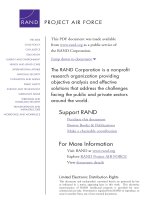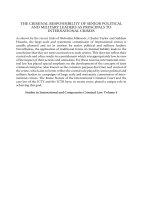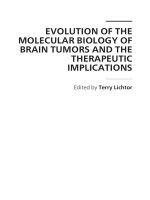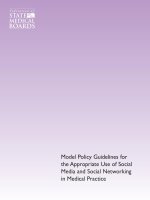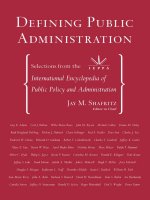the professional development of teachers practice and theory
Bạn đang xem bản rút gọn của tài liệu. Xem và tải ngay bản đầy đủ của tài liệu tại đây (4.56 MB, 219 trang )
The Professional Development of Teachers: Practice and Theory
This page intentionally left blank
The Professional Development of
Teachers: Practice and Theory
by
Philip Adey
King’s College London,
United Kingdom
with
Gwen Hewitt, John Hewitt and Nicolette Landau
KLUWER ACADEMIC PUBLISHERS
NEW YORK, BOSTON, DORDRECHT, LONDON, MOSCOW
eBook ISBN: 1-306-48518-4
Print ISBN: 1-4020-2005-8
©2004 Kluwer Academic Publishers
New York, Boston, Dordrecht, London, Moscow
Print ©2004 Kluwer Academic Publishers
Dordrecht
All rights reserved
No part of this eBook may be reproduced or transmitted in any form or by any means, electronic,
mechanical, recording, or otherwise, without written consent from the Publisher
Created in the United States of America
Visit Kluwer Online at:
and Kluwer's eBookstore at:
DEDICATION
for Jennifer Adey
… not just for her love and support for 40+ years, but for many valuable
professional insights into the matter of this book from her experience as a
headteacher, OfSTED inspector, and consultant.
v
This page intentionally left blank
CONTENTS
Abbreviations and Notes ix
PART 1: THE ISSUES AND SOME ATTEMPTED SOLUTIONS
Chapter page
1 Introduction 1
2 Evolving principles: experience of two large scale programmes 9
3 Professional development for cognitive acceleration: initiation 17
4 Professional development for cognitive acceleration: elaboration 31
PART 2: EMPIRICAL EVIDENCE
5 Measurable effects of cognitive acceleration 51
6 Testing an implementation model 65
7
A long-term follow-up of some CASE schools
83
8 Teachers in the school context 97
9
Making the process systemic: evaluation of an authority
119
programme
PART 3: MODELLING PROFESSIONAL DEVELOPMENT
10 Researching professional development: Just how complex is it? 143
11 Elaborating the model 155
12 Evidence-based policy? 175
References 197
Index 205
vii
This page intentionally left blank
CC
ABBREVIATIONS AND NOTES
CA Cognitive Acceleration
CAME Cognitive Acceleration through Mathematics Education
CASE Cognitive Acceleration through Science Education
CATE Cognitive Acceleration through Technology Education
CASE Coordinator (Person in a school responsible for implementation of
CASE)
DfES Department for Education and Skills (the government ministry in
England responsible for education)
GCSE General Certificate of Secondary Education (national examination taken
at end of Y11 in England and Wales)
HoD Head of Department (in a school)
HoS Head of Science (department in a school)
INSET Inservice Education of Teachers
KS1 etc. Key Stage 1 etc. (see table below)
LEA Local Education Authority (or ‘Local Authority’)
LoU Level of Use (of an innovation)
NLS National Literacy Strategy
NNS National Numeracy Strategy
NQT Newly Qualified Teacher (in their first year)
OfSTED Office for Standards in Education (who inspect schools in England).
PD Professional Development – in the context of this book, this refers
generally to the continuing development of teachers after their initial
training.
PKG Permatan Kerja Guru – literally ‘improving the work of teachers’.
Y1 etc Year 1 etc. (see table below)
WISCIP West Indian Science Curriculum Innovation Project
ZPD Zone of Proximal Development
Ages, years, and grades in different systems
Age, years 5+ 6+ 7+ … 10+ 11+ 12+ 13+ 14+ 15+ 16+ 17+
England Y1 Y2 Y3 … Y6 Y7 Y8 Y9 Y10 Y11 Y12 Y13
Key Stage 1 2 3 4 5
School * primary secondary
Scotland P1 P2 P3 … P6 P7 S1 S2 S3 S4 S5
US grade K 1 2 … 5 6 7 8 9 10 11
* details vary widely across (and within) Local Authorities. For example, some have
middle schools Y4 – Y7 or Y8.
ix
This page intentionally left blank
PART 1: THE ISSUES AND SOME ATTEMPTED
SOLUTIONS
1: INTRODUCTION
AN OUTLINE OF OUR AGENDA
We have subtitled this book ‘Practice and Theory’ because that is the order in which
we plan to deal with the subject. We have been running and evaluating programmes
for the professional development of teachers since 1970 and the first section of the
book will describe some of that practice and the principles which have emerged, and
then been re-cycled back into the practice. Key amongst those principles are:
• the necessarily long-term nature of inservice programmes which are to have a
permanent effect on teaching practice;
• the central role of coaching work in schools; and
• the interaction between individual teacher factors and the department and school
environment which encourages or discourages professional development.
Part 1 will describe some of the main professional development programmes for
teachers with which we have been involved – in outline only for the earlier ones –
and show how these principles emerged and how they work out in practice. We will
also explore some of the problems, economic and other, associated with following
them rigorously.
In part 2 we will present a varied body of empirical evidence concerning the
effectiveness of professional development programmes. Most of this evidence has
been reported previously only at conferences and here it will be laid out for closer
inspection, and also collected together so that we can see how it accumulates and
contributes to something like a unitary story. It comprises both quantitative
evidence including gains in student achievement which can be attributed to the
teachers’ inservice courses, and also qualitative data obtained from questionnaires,
interviews, and prolonged observations of classes of teachers participating in
professional development (PD) courses.
There is, of course, already a substantial literature concerned with professional
development in general, professional development of teachers, and the issue of
educational change. We could not presume to offer new insights into effective
professional development of teachers without recognising the enduring work of
such scholars as Michael Fullan, Thomas Guskey, Andy Hargreaves, David
1
2 Introduction
Hopkins, Bruce Joyce, Michael Huberman, Matthew Miles, and Virginia
Richardson. But we have chosen to present our own experience and empirical data
first and then, in Part 3, to show how this experience and data relates to models
which have been proposed by others. We will address here methodological issues
concerned with collecting and interpreting evidence of relationships amongst the
many individual and situational factors associated with PD, and re-visit the
arguments about ‘process-product’ research on PD. In the light of our experience,
we will interrogate models of PD which have been proposed by others and attempt
to move forward our total understanding of the process of the professional
development of teachers for educational change. In conclusion, we will look at
some current national practice in professional development, concentrating on the
recent English experience of introducing ‘strategies’ into schools but referring also,
by way of contrast, to the situation in the United States.
WHAT’S THE PROBLEM?
Why has the professional development of teachers already exercised so many good
minds for so long? And how can we justify adding another book to this field? The
answer to both questions must lie in the continuing demand from society in general
(at least as interpreted by politicians and newspaper editors) for improvements in
the quality of education. We are not here going to question the meaning of
‘standards’ in education, nor the validity of claims and publicly held perceptions
about such standards, and we cannot be bothered to interrogate the motives of many
of those who loudly express their horror at supposedly falling standards. (It is
disappointing that even Michael Fullan (2001, p.47) occasionally makes glib
statements such as “Most people would agree that the public school system is in a
state of crisis”) And we do not have to buy into the cataclysmic view of the rate of
change in society fostered by futurologists such as Gleick (1999) and Toffler (1970)
to accept that change is occurring, and that it is inevitable, is demanding of
attention, and is welcome. It is welcome because a system which does not change is
one which stagnates, and it demands attention, obviously, because methods of
running a classroom, or school, or local authority, or government which worked fine
20 years ago will not work well now. The story of evolution is one of continuous
change – sometimes so slow that we cannot detect it over hundreds of years,
sometimes radically metamorphic. Species which fail to adapt become extinct.
Actually, the justification for continuing to chip away at the problem of
professional development is quite simple. A desire to improve the quality of
education is a perfectly respectable aim in its own right, and is one that will always
continue, that should always continue, whatever successes may be achieved on the
way. One school or one local education authority (LEA), or one country may
achieve standards of instruction, provision of resources, and harmonious and
productive relationships amongst teachers and students that would be the envy of
the world, and yet still feel that more could be done, or at the very least that hard
3 Introduction
work must be put in to ensure that those standards are maintained. So, the raising
and maintenance of educational standards is a continuous quest, and the central
players in that quest must be the teachers.
“Educational change depends on what teachers do and think – it’s as simple and as
complex as that” (Fullan & Stiegelbauer, 1991) p. 117
Hopkins & Lagerweij (1996) characterise decades of attempts to improve education
as: 1960s, curriculum development and a belief that materials alone would do the
job; 1970s, failure of this approach and much hand-wringing; 1980s, success of the
school effectiveness movement in identifying key factors in successful schools, and
the 1990s as the decade of pro-active school improvement. In his own ‘Improving
the Quality of Education for All’ project, Hopkins noted as one of the important
conditions which underpin improvement efforts a commitment to continuing staff
development (p. 81). We would add, not just commitment, but an understanding of
staff development methods which are effective.
Perhaps here an aside is in order about possible alternative routes to educational
success which appear to by-pass teachers – the teacher-proof curriculum, the tightly
specified lesson plan, and the computer-delivered lessons. It should not even be
necessary to write this paragraph as we guess that it will be blindingly obvious to
the great majority of our readers, but just in case someone
1
out there still believes in
such by-passes, here goes. Education is first and foremost a social process, one that
occurs between people. Whatever the de-schoolers or futurologists might argue, it is
not an historical accident, nor a throw-back to medieval practice, nor the hopeless
inertia of the system that has led all school education, everywhere in the world, to
be conducted in ‘classes’ of from 15 to 90 students with one ‘teacher’. The reason
that the process of teaching and learning – even rather bad, didactic, teaching – can
never be adequately replicated by a teaching machine, a computer, interactive video,
or hypermedia text is that no machine can get near to managing the billions of subtle
interactions which occur amongst even 30 students and between them and their
teacher. Schön (1987) describes the artistry of the professional (including teachers)
and the impossibility of reducing this artistry to some form of technical rationality.
This is more than just saying that there are too many variables for a machine to
handle for if that were all it was, machine development would soon catch up. It is
that too many of the variables are indeterminate and manifest themselves anew
whenever the context changes. Only a human agent can even approximate the most
appropriate responses required to achieve a particular instructional goal with a
group of other human beings. Human teachers are and will remain at the centre of
the educational system, and thus the continuing professional development of
teachers remains the most important force in the quest for educational improvement.
1
At a dinner party while writing this book, the city types around the table agreed unanimously that star
presenters of history and nature programmes on television were so excellent that they should be
employed to make programmes to cover the school curriculum, which could then be shown in place of
the teachers’ ‘boring’ lessons. Then all the schools would need would be someone to take the register,
turn on the video player, and stop fights in the playground. Obvious, really.
4 Introduction
That is the justification for continuing to pay attention to professional
development. The justification for this particular book will become apparent. It lies
in our unique and prolonged experiences with extensive professional development
programmes and the lessons which may be learned from them.
THE CONTEXT OF OUR WORK, AND ITS GENERALISABILITY
We would like to contextualise our work at two levels: within the school
improvement literature in general and then as a specific example of professional
development.
Professional Development and School Improvement
The radical conservative agenda of the 1970s in the United States and the United
Kingdom turned an ‘accountability’ spotlight on to education. Education, it was
argued, had much in common with any service industry: it had aims, outcomes,
clients, stakeholders, and people who paid for it (generally the taxpayer). Since a
main item of the agenda was to reduce taxes, the education system was required to
account for its performance and to demonstrate cost-effectiveness. Notwithstanding
a major problem in agreeing what counted as useful outcomes – for the
manufacturer, these may be basic literacy and technical skills, for the service
provider, interpersonal abilities and for the university admissions tutor, academic
excellence – the political demand released funding for a wave of studies of
educational effectiveness and educational change. This work has had a long-lasting
impact both on methods of assessing effectiveness (e.g. Miles & Huberman, 1984)
and on the construction of macro-models of educational change (e.g. Fullan, 1982;
Fullan & Stiegelbauer, 1991). Early sociologists’ suggestions that schools actually
made very little difference to students’ academic and personal development were
countered by sophisticated longitudinal studies incorporating multi-level modelling
which demonstrated unequivocally that school variables under the control of the
school’s managers did indeed have a significant effect on the variance in outcomes
for students (e.g. Mortimore, Sammons, Ecob, Stoll, & Lewis, 1988; Rutter, 1980).
Once it was established that schools did make a difference, attention could be turned
to just how less-good schools could be improved, and the school improvement
literature was born. Two excellent examples of this genre are provide by Joyce,
Calhoun, & Hopkins (1999) and Stoll & Fink (1996), each of whom draws on
experience, research, and imaginative analyses to present practicable ideas for
improving schools by multi-pronged attention to a diverse range of parameters.
Although it constitutes only one of these prongs, the professional development
of teachers is central to all plans for school improvement. In this book we will be
recognising this centrality and focussing particularly on methods of effective
professional development and its evaluation, but we recognise that this does only
5 Introduction
represent one of the aspects of the whole school situation which requires attention
for substantial and lasting improvement. In short, professional development of
teachers lies nested within school improvement, which in turn is part of the larger
picture of educational change. Of course, the term professional development has a
much more general applicability than to teachers only. Schön (1987), who is
frequently quoted by educators for his wisdom on the idea of the reflective
practitioner, was actually more generally interested in the university education of
professionals, including architects and engineers as well as teachers. The
department within which I work at King’s College London is called the Department
for Education and Professional Studies, a title much wrangled over but agreed
because of the attention we pay to the professional development of health workers
and priests as well as of teachers. The location of the subject of this book can thus
be simply represented as a Venn diagram (figure 1.1).
Educational
change
School
improvement
Professional
development
Professional
development
of teachers
Figure 1.1: Locating the Professional Development of Teachers
By choosing a focus which is more limited than that of school improvement or
professional development in general, we recognise that it is incumbent on us to offer
a deeper treatment of the specifics of the professional development of teachers than
might be expected from those wider literatures.
Cognitive Acceleration as a Context for Professional Development
The main work we are presenting and discussing in this book is a series of
professional development programmes that we have run since 1991 to enable
teachers to help their students develop higher level thinking. These are the
“cognitive acceleration” programmes. There were important precursors to this work
which we will describe in Chapter 2, but it is the professional development for
cognitive acceleration which has set the greatest challenges and from which we have
learned so much.
6 Introduction
There are occasions where PD legitimately has quite limited aims, such as the
introduction of a new assessment technique, or of a new textbook, or a new piece of
software. Such aims may well be achievable by courses of one day or less because
no attempt is being made to alter teachers’ implicit models of teaching and learning
and the aims of the inservice do not include shifts in beliefs and attitudes. They are
limited to the introduction and practice of some straightforward technique. This is
not the type of professional development with which this book is concerned. We are
concerned with deep-seated changes in pedagogic practice which cannot be brought
about without addressing both individuals’ fundamental attitudes to teaching and
learning and also a whole school’s commitment to change. Teaching for the
development of thinking does require a radical shift in pedagogy for most teachers,
as well as fostering the support of colleagues within an institution. Cognitive
acceleration also has a long and respectable track record of showing long-term
effects on students’ cognitive growth and academic achievement. It is thus an
excellent example of an innovation which is of ‘good quality’ in the sense used by
Fullan (1999, p. 80) and which makes heavy demands on professional development.
Cognitive acceleration is a ‘hard case’: if PD for cognitive acceleration can be
shown to be effective, then it must be doing quite a lot right and many of the same
methods of the PD may be abstracted and applied to any professional development
programme which aims at changing more than simple technical capability. We
claim, therefore, that the lessons we have to offer on PD can be generalised far
beyond the context of teaching for higher level thinking. (It should not, however, be
thought that cognitive acceleration is a narrowly focussed context. In Chapter 3 we
will say something of the international and inter-domain nature of cognitive
acceleration in the 21
st
century.)
The point here is not that cognitive acceleration is being proposed as a ‘magic
bullet’ or ‘cure-all’ system for raising achievement, although we think it’s pretty
good stuff. It is that it is the sort of innovation which requires deep level change in
individuals and in institutions, and has lessons to offer far beyond that of a
particular innovation.
A NOTE ABOUT AUTHORSHIP, AND ACKNOWLEDGEMENTS.
Most of the text of this book has been written by the first author, Philip Adey. But
one of the main justifications for writing the book lies in the empirical data of Part 2
which has substantial contributions from Nicki Landau (especially chapter 8) and
from Gwen and John Hewitt (especially chapter 9) and these colleagues are
recognised as assistant authors. ‘I’ generally means Philip Adey, describing
personal experiences and opinions, although in chapter 8 the ‘I’ is Nicki Landau.
The use of ‘we’ generally demonstrates collective responsibility we have taken in
drafting, editing, and refining the text although in chapter 9 the ‘we’ is John and
Gwen Hewitt.
7 Introduction
There are many others whose ideas and support have been invaluable over the
years of experience of PD programmes, people we have worked alongside and from
whom we have learned. A.J. Mee was a wise mentor in my early days of PD in the
Caribbean. Benny Suprapto created the conditions for, and Gordon Aylward and
Theresia Pietersz executed, one of the most remarkable PD programmes that has
ever been implemented, to be described in chapter 2. I was fortunate indeed to be in
Indonesia at the time and to have the chance to work with them. Through the years
of developing PD programmes for cognitive acceleration I have learned much from
watching, listening to, and being criticised by many colleagues and friends,
including Carolyn Yates, Chris Harrison and Tony Hamaker, Anne Robertson and
Grady Venville, Natasha Serret and Justin Dillon, and many others. We have also
learned an enormous amount from the teachers we have worked with. Both
explicitly and inadvertently they have steered the development of our methods and
the development of our understanding of the process of the professional
development of teachers. I am grateful also to the anonymous reviewer of the first
draft of this book for his or her perceptive comments.
Finally, all of the cognitive acceleration work rests on the original vision of my
mentor and friend, Michael Shayer with whom I have worked since 1974. The
development of the theoretical models which underlie cognitive acceleration, and
the generation and testing of hypotheses and of practical procedures have been
developed through a constant process of dialogue between us in which I can always
rely on Michael for deep insight and for connection to a remarkably wide range of
literature and experience. Not least importantly, virtually all of the statistical
procedures used for assessing gains by CA students were developed by Michael,
and he was actually responsible for many of the specific analyses reported here.
This page intentionally left blank
2. EVOLVING PRINCIPLES: EXPERIENCE OF TWO
LARGE SCALE PROGRAMMES
In 1970 I was not yet 30 years old, but after 7 years of teaching chemistry in a
selective boys’ school in Barbados I landed a job which seemed to me then (and still
does now) to be like the best kind of dream. The job was to be the “Regional
Consultant” in developing and introducing a new integrated science curriculum into
junior secondary schools in 15 countries, almost all in the Eastern Caribbean.
Mainly this was a curriculum development project to build on material (the West
Indian Science Curriculum Innovation Project, WISCIP) which had been initiated
by Iolo Wynn Williams and Harrod Thompson in Trinidad which in turn owed
much to the then new Scottish integrated science curriculum. The relevance of this
work to the present volume lay in the professional development programme
associated with it. At this remove I am not sure how we designed the programme (or
maybe I was never privy to that), but two important principles seemed to be taken
for granted: (1) educational practice in schools would never be influenced by
printed materials and kits of apparatus alone, however detailed the teachers’ guide,
however comprehensive the resource kit; and (2) even the addition of a series of 3-
day inservice courses would be unlikely to have much impact unless we ourselves
got into the classrooms to help the teachers implement the curriculum in their own
context.
All of this was long before the ideas of ‘coaching’ or of ‘school-focussed
INSET’ had been formalised, and yet it seemed obvious to us at the time. Nothing I
have done in the field of professional development since then has disabused me of
this belief. Rather, a further 30 years of experience (as well as much reading of
others’ experiences) has confirmed this simple truth: if you want to change what
happens in schools, then you need to get into schools. For the first three years of the
1970s, virtually every term-time week saw me on a little plane to St. Vincent, to St.
Lucia, or Dominica, occasionally further afield to somewhere like the Cayman
Islands or Turks and Caicos, driving around the islands with school inspectors,
observing lessons and offering feedback, listening to teachers’ stories of success and
difficulties, and learning all of the time from their experiences.
Although the project did put good resources into about one hundred schools, and
did provide the teachers with some sort of entrée into constructivist science
teaching, it was not an unmitigated success for all of the schools involved. The
limited nature of my own experience, and even the limited nature of my own subject
knowledge outside of chemistry, led me to make mistakes and some crass
suggestions. It took time for it to dawn on me that conceptual teaching which had
worked pretty well with my bright grammar school boys could not simply be
transferred unaltered to a class in an all-age school, from which the grammar stream
children had been selected out, in up-country Guyana. (That this realisation
9
10 Evolving Principles
eventually led me back to university to research cognitive development may have
been a useful pay-off for me, but it didn’t do a lot at the time for the children or
their teachers.)
At this remove I would hesitate to comment on the cost-effectiveness of the
WISCIP project. That was a time when overseas development agencies of British
and American governments had great faith in science education as a long-term route
to economic development and WISCIP was probably a lot better than many projects
which dropped kits of apparatus into schools around the world, enriching equipment
manufacturers but leaving many an under-educated science teacher bemused at
boxes which had arrived without any prior consultation about what might actually
be useful.
In retrospect I would say two strong messages started to formulate themselves
from the WISCIP experience about effective professional development, in addition
to the faith in in-school coaching and the realisation that there were no quick fixes.
The first arose from my observation that, even after two years, I would so often
“just miss” seeing a science lesson in a school which I visited. The time and date of
my visit would have been sent in advance, but somehow the lesson was going to be
tomorrow, or had been yesterday, or the children had been called to a sports day, or
the keys couldn’t be found to the lab (yes, really). Changing your teaching practice
is a frightening thing. Once you move from dictating notes from the textbook
(possibly the only experience you have had of education thus far) you are entering
an uncertain world. You don’t want to do it in front of a stranger. And you don’t
want to do it by yourself. The safest strategy is to lose the lab keys. What this says
about coaching is that coaching is not dropping in off an aeroplane to observe a
lesson, make some encouraging comments, and moving on the next island. We will
have more to say about what coaching is in chapters 4 and 11.
The second lesson is more positive. It is that the best experience that teachers
have in inservice courses is talking with other teachers. In the WISCIP context
teachers would fly in from all over the Caribbean to a campus of the University of
the West Indies in Barbados or Jamaica, stay in student accommodation for a few
days, take part in WISCIP workshops during the day – with plenty of opportunity
for participant interaction – and then socialise in the evening. They learnt far more
from each other than they ever did from us. The teacher with a bullying headteacher
learned that she was not alone. The man who had said WISCIP was impossible
without a fully equipped laboratory learned how others were coping. Most of all
(and this only after a few sessions) teachers learned that others were as vulnerable as
they were, and that help and sympathy could be obtained by sharing fears,
difficulties, and ‘errors’. The process of change became a little less frightening.
11 Evolving Principles
THE INSERVICE-ONSERVICE MODEL IN INDONESIA
1
The Dutch colonial powers in the East Indies did not set much store on the
education of the indigenous people, and when Indonesia finally gained
independence in 1948 (after a ‘police action’ in which the British helped the Dutch
try to regain their former territories after the defeat of the Japanese in 1945) it was
faced with establishing an education system virtually from nothing. For Sukarno,
leader of the independence movement who became the first President of the
Republic of Indonesia, the immediate priority was to weld together as one country a
set of five large land masses and some 3000 smaller islands, covering an area about
5000 km East to West by 3000 km North to South and population of around 150
million incorporating a bewildering diversity of languages, religions, cultures, and
levels of development. From his power base in Java he did this remarkably
successfully through a combination of clever diplomatic moves (such as making a
variant of the widely used Malay trading language, Bahasa Indonesia, the national
language rather than try to impose Javanese, and by consulting closely with the
Governors of the 27 Provinces) and force, using the predominantly Javanese-led
army which had successfully harried the Japanese and made life so miserable for the
Dutch and British that they had to abandon their ‘police action’. In line with this
political welding together of the country, the education system was massively
centralised. General school education had three levels: elementary (Sekolah Dasar,
SD), junior secondary (Sekolah Menengah Pertama, SMP) and senior secondary
(Sekolah Menengah Atas, SMA). The system grew at an extraordinary rate, such
that by 1970 the percentages of the population able to attend each level of this
system were something like 80% at SD, 40% at SMP, and 15% at SMA. Teacher
Universities (Institut Keguruan dan Ilmu Pendidikan, IKIP) and faculties of
education within regular universities (FKIP) were established but their capacities
(and capabilities) fell far short of the demands of the rapidly expanding system.
Thus the achievement of educational expansion came at the cost of years of
emergency training of teachers, some of whom received no more than one year
teacher training beyond the level at which they were expected to teach. Even those
fortunate enough to complete a 2 or 3 year Diploma, or even a 4 year degree, at an
IKIP or FKIP generally experienced a programme in which subject matter content
and educational theory were rigorously separated and taught by different
departments (Van den Berg, 1984). University-level education departments in
Indonesia suffered the same problem as education departments in many parts of the
world (notably the United States): in fighting to establish their academic credibility
in a university environment, they so fear being labelled ‘vocational’ that they lose
touch with the reality of schools and become overly academic. This syndrome has
been well documented by Donald Schön (1987).
1
Much of the information of this section comes from personal experience of working as a British
Council Education Officer, seconded part-time to the Indonesian Ministry of Education and Culture, from
1981 – 1984 and many subsequent visits as a consultant on Governement of Indonesia, World Bank, or
UNESCO teams.
12 Evolving Principles
The quality of education in schools, inevitably, reflected this under-educated
teaching force, and the problem was exacerbated by the low pay of teachers which
meant that they generally had to teach two shifts - the same building being used for
different schools in the morning and in the afternoon - in order to make a living.
There is no time for preparation or marking in this situation.
From the 1970s there was a concerted effort to address the problem of quality by
running national inservice workshops for selected teachers and local inspectors. The
focus of these workshops was mostly child-centred learning and activity-based
teaching methods, although some attention was paid to teachers’ content
knowledge. Participants came from all of the 27 provinces, and on their return were
supposed to cascade their new knowledge through a series of steps in order to reach
as many teachers as possible. From the perspective of the 21st century and all that
has been written about cascade methods, it is hardly surprising that this effort,
although well-meant and rather expensive, had very little impact on practice in
schools.
In 1979 the Department of Education and Culture of the Government of
Indonesia initiated a project called PKG (Pemantapan Kerja Guru - improving the
work of the teachers) which was to become the biggest inservice project anywhere
in the world. Funding was obtained initially from UNESCO and UNDP, and later
the World Bank became involved. Since its inception PKG has had an ambitious
objective: to learn from previous attempts at cascade models of inservice education
and to reach directly into thousands of junior and senior secondary schools (SMP,
SMA) throughout the 27 provinces of Indonesia. The aim was to shift the locus of
control, if only slightly, from teachers as purveyors of knowledge (or, commonly, as
mediators of the knowledge enshrined in a textbook) towards the students as active
constructors of their own understandings.
From the start, the originators of the project – Dr. Benny Suprapto, Director of
Secondary General Education; Theresia Pietersz, National Project Consultant, and
Dr. Gordon Aylward, a consultant from Australia – were committed to the idea of a
substantial onservice element – that is, work with teachers in their own schools as
well as at inservice days organised in central locations. As with the assumption we
had made in the Caribbean, this decision was probably based less on the theoretical
considerations than on the originators’ combined experience of inservice teacher
education projects in various parts of the world. Expensive but centrally-based
projects had too often been seen to founder as soon as external funding terminated.
Another lesson that had been learnt was that although the IKIPs and FKIPs
contained some talented individuals, as institutions they were more likely to be
obstructive than facilitating in the process of pedagogical change, for the reasons
outlined above. It was therefore necessary to work around them, which in the
Indonesian context required some deft political foot-work.
An immediate question is, how can one possibly provide in-class coaching to
many thousands of teachers spread over such a vast and varied area where
communication in the many remote regions was often extremely difficult? What
would be the cost and logistics involved in deploying the army of teacher-coaches
Evolving Principles 13
required? PKG’s solution was entirely appropriate to the situation: draw coaches
from the ranks of teachers themselves. Over the years there have been many
modifications to the detail, but the basic model involved the following steps:
1 With the help of provincial and district authorities, use criteria including
experience, qualifications, and tests of content knowledge to select a cadre of
existing teachers from the secondary schools who seemed to be better qualified
and motivated than the average.
2 Take this cadre of teachers for specialist training workshops at provincial,
national, regional, and on occasion at international workshops.
3 Return them to their own schools for a semester, where they practice for
themselves the methods they have learned, and meet weekly in small groups to
share experiences. National consultants make inputs and monitor these meetings.
4 Accredit this cadre of trained and experienced teachers as ‘Instructors’ or
Assistant Instructors (depending on the training they had received). Later
another layer of coach was recruited, the Key Teachers (Guru Inti). Instructors
now become responsible for running the main training programmes in their
Provinces. These programmes last one semester each, and consist of :
a. a two week introductory workshop
b. meetings every Saturday throughout the semester
c. coaching visits by the trainers to teachers in their own schools during the
week.
There are also a mid-semester one week workshop and an end-of-semester one
week workshop for reflection and transfer work.
5 Trainers and key teachers meet at annual national workshops to reflect on their
coaching practice and to develop new content materials.
There are many more aspects to this vast professional development programme than
can be detailed here, but in summary it operated as a sort of two or three-step
cascade, but with a critical added element of feedback up the cascade, and continual
monitoring by the national team of national and provincial workshops to maintain
quality and guard against the classic dilution effects which beset standard cascade
models. The feedback process ran in a series of loops from teachers’ own inputs to
the development of materials and their evaluation of materials provided, up through
local, provincial, regional, and national training and writing workshops. There was a
remarkable degree of consultation at every level. (For a more detailed account of the
PKG system, see Thair & Treagust (2003), although we do not necessarily buy into
the implications which they draw.)
Evaluation
When I joined the project in a part-time capacity in 1981, it took me perhaps six
months to move from scepticism that such a grandly conceived programme with
such a small central team could possibly have any effect at all, through a phase of
incredulous wonder, to one of more evidence-based conviction that here was a
model which, at least in the highly consensual culture which characterises most of

